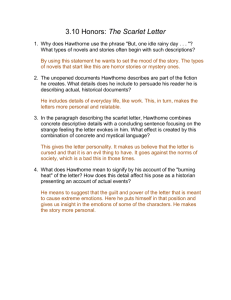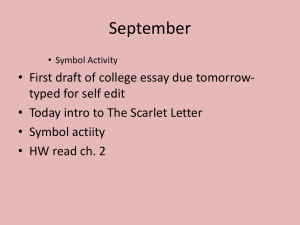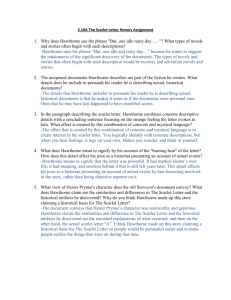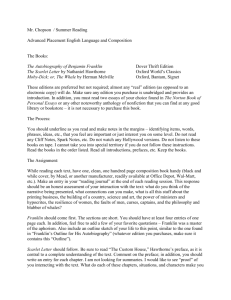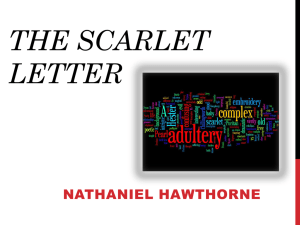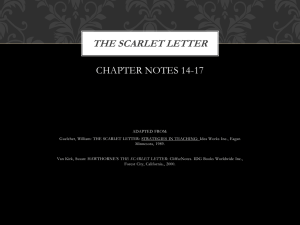Indigenous Injustice, Indians in The Scarlet Letter
advertisement
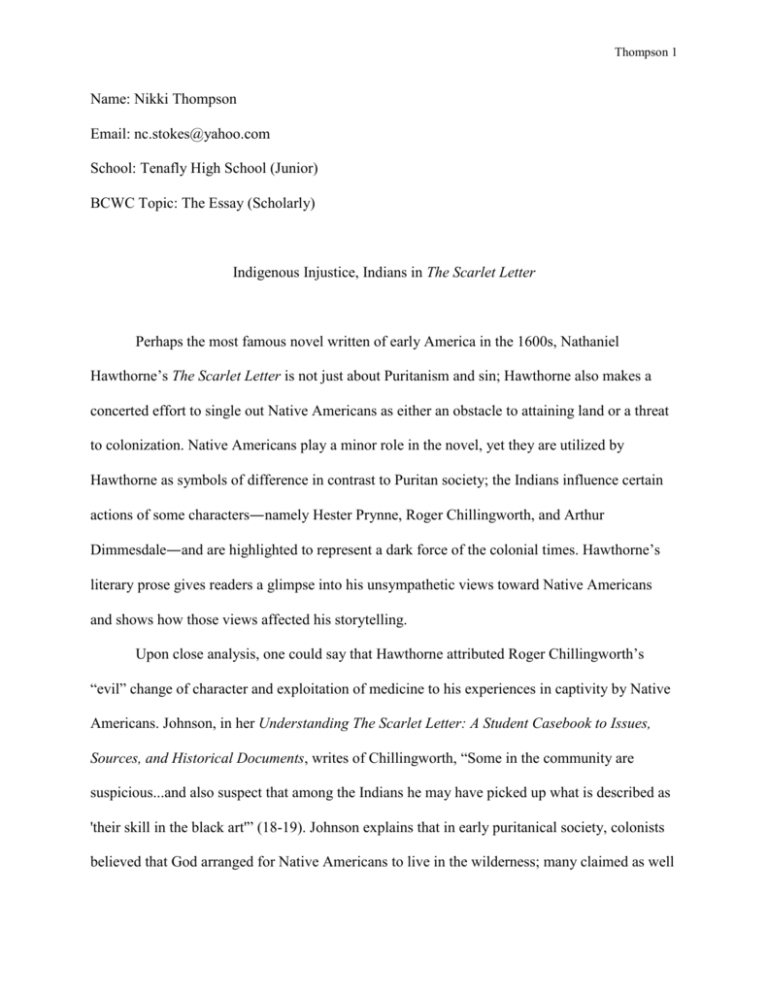
Thompson 1 Name: Nikki Thompson Email: nc.stokes@yahoo.com School: Tenafly High School (Junior) BCWC Topic: The Essay (Scholarly) Indigenous Injustice, Indians in The Scarlet Letter Perhaps the most famous novel written of early America in the 1600s, Nathaniel Hawthorne’s The Scarlet Letter is not just about Puritanism and sin; Hawthorne also makes a concerted effort to single out Native Americans as either an obstacle to attaining land or a threat to colonization. Native Americans play a minor role in the novel, yet they are utilized by Hawthorne as symbols of difference in contrast to Puritan society; the Indians influence certain actions of some characters—namely Hester Prynne, Roger Chillingworth, and Arthur Dimmesdale—and are highlighted to represent a dark force of the colonial times. Hawthorne’s literary prose gives readers a glimpse into his unsympathetic views toward Native Americans and shows how those views affected his storytelling. Upon close analysis, one could say that Hawthorne attributed Roger Chillingworth’s “evil” change of character and exploitation of medicine to his experiences in captivity by Native Americans. Johnson, in her Understanding The Scarlet Letter: A Student Casebook to Issues, Sources, and Historical Documents, writes of Chillingworth, “Some in the community are suspicious...and also suspect that among the Indians he may have picked up what is described as 'their skill in the black art'” (18-19). Johnson explains that in early puritanical society, colonists believed that God arranged for Native Americans to live in the wilderness; many claimed as well Thompson 2 that Indians were loyal to the devil (18-19). Hester’s affair occurs when Chillingworth is a hostage, and when he arrives in Boston, Chillingworth’s revenge drives him to extremes—he does things like use drugs to try to extract the truth from Dimmesdale. Hawthorne suggests that it is the Native Americans who are to blame for the unethical medical practices used by Chillingworth and for his seemingly devilish metamorphosis. Hawthorne does this by claiming that Chillingworth was a moral and sound doctor, as well as scholar before later becoming “corrupt” while held by the Indians who practice so-called “black magic.” Indians also play a part in Arthur Dimmesdale’s momentary change of personality. Chapter eighteen begins with explaining how Dimmesdale has a heavy guilt weighing on his mind, and how his “sin of passion” is causing him to drive himself insane (Hawthorne 174). He is skeptical about running away with the brave Hester, for he “has never gone through an experience calculated to lead him beyond the scope of generally received laws” (174). Yet a short while after, he passionately decides that he is ready to leave the Puritan life behind. Gone is his religious piety. Gone is his moral prison. All that remains is an enthusiastic priest who momentarily forgets all of his obligations as a clergyman. Dimmesdale’s new feeling of freedom and disregard for commitment is in actuality a device used by Hawthorne, who uses Dimmesdale returning from a visit to the Indians as an opportunity to show what the outcome of such a journey can be, and what an irresponsible impact the Indians can have on one who was once so pure. Dimmesdale leaves his inhibitions and ethics behind, and by tainting the personality of a character whose initial role is to bring religious justification and morality to his people, Hawthorne is able to stress the pagan depravity in the Indian culture and community; therefore, Hawthorne seems to be suggesting that without Christianity, the Indians are unable to be morally or ethically sound. Thompson 3 Native Americans are shown to be a negative influence again through the use of Hester Prynne’s almost-exile from the town of Boston. In chapter five of the novel, Hawthorne writes of how Hester, once released from prison, lives on the outskirts of her former town. Indians come into play here, as Hester could choose to go just a bit further and live with the Native Americans in the wilderness, where there is a free and nonjudgmental society willing to welcome her. She instead chooses to withstand her sin and stay within the boundaries of Boston, not willing to venture out into an unfamiliar civilization that has a negative reputation and is tantamount to banishment. The usage of Native Americans in The Scarlet Letter helps to demonstrate similarities between natives and Hester. Gussman, in her “Inalienable Rights: Fictions of Political Identity in ‘The Scarlet Letter’” writes how people like Indians and witches are similar to Hester Prynne; each represents an outcast among the Puritan world. She explains that these people have qualities that threaten the harsh, strict life that Puritans lead, including “intellectual license and female prophesying” in addition to “passion, pride, and disrule” (72). Hester, with her strong personality and mature attitude, proves throughout the novel that she is dismissive of other people’s opinions. In the 1600s, Indians also rejected the thoughts of others. Ironically, Native Americans were just as obsessive about their way of life as the Puritans. They had strict dances, celebrations, jewelry, and medicinal procedures for all of which they did not want to consider any alternate foreign options. For example, the Iroquois had “an elaborate political hierarchy incorporating villages into nations and nations into a confederation” (Norton 10). In addition, all Native Americans were polytheistic, with gods specialized for activities ranging from hunting to farming, very different from the Puritan religious beliefs consisting of just one god. Native Americans would hold celebrations and dinners just for these gods to welcome good fortune into Thompson 4 their lives (Norton 11). The commitment to dance and celebration is evidence of the rigid belief they had in using such procedures to encourage harvest and a fruitful life. Both Indians and Puritans were beholden to their customs and their rituals of life, and the Indians certainly did not want to waver or adjust to a different lifestyle. The characteristics displayed by Hester and Indians could have been detrimental to the rigid order that had been set in place by the leaders of Puritan society, and the only way for Puritans to get rid of those characteristics was to drive away those who possessed any strong, threatening qualities. The Puritans (as well as other colonists in the 1600s) pushed out Indians, claiming they belonged as savages in the wilderness and were a threat to the development of colonies. Likewise, the Puritans of Boston force Hester to leave the nucleus of the town, claiming that her sin is not welcome among society. Piper writes in her “Misfits and Marble Fauns: Religion and Romance in Hawthorne and O’Connor,” “Branding her with the scarlet letter for her act of adultery, they banish her to a small cottage ‘on the outskirts of town’(81), where she is no longer a threat to their civilization” (48). According to Newman, who wrote on the subject of the Native Americans in relation to Hester, “Hawthorne particularly notes the ‘savage finery of their curiously embroidered deerskin robes,’ so reminiscent of the wild imagination that had curiously embroidered a scarlet A” (11). This commonality that Newman points out reads almost as a subplot at various points in the novel. The Puritans reject Hester and the Indians because, as Newman writes, they are so similar—being that they do not not follow the dull, plain order that Puritan life followed—and are both seen as rebellious in the Puritans’ eyes. Native Americans had flamboyant and colorful cloaks; they painted different colors on their faces and paid great attention to detail. Likewise, Hester is able to take the dreary scarlet A she is forced to wear on her breast and turn it into a magnificent, detailed, gold-embroidered Thompson 5 stitching. These imaginative and lively ideas create unnerve among those who represent the “sad gray, brown, or black of the English emigrants” (Hawthorne 202). The desire to stand out and make light of situations angered the Puritans, who wanted so desperately for everyone to fit into their ordinary existence. Based on all of the similarities Hawthorne alludes to Hester and the Native Americans, one might argue that he actually has sympathy for the Indians, since he clearly favors Hester over the Puritans. Hawthorne describes Hester in an acclamatory manner, in terms of both beauty and personality. He describes her as “tall, with a figure of perfect elegance,” with “a face, which, besides being beautiful from regularity of feature and richness of complexion, had the impressiveness belonging to a marked brow and deep black eyes” (3). While continuously using the word “ladylike” to describe her outer-self (3), he also writes “so strong was Hester Prynne, with a woman’s strength” (156), describing her inner-self. How, then, could one claim that Hawthorne writes negatively of Native Americans if he compares them to Hester, of whom he writes so highly? Hawthorne may compare them, but he clearly has a different sentiment toward Hester than he does toward Native Americans. Hawthorne sees Hester as the one ray of sunshine among the dreary life of Puritans in Boston, while he most likely, in keeping with national sentiment of the time of the novel, sees Native Americans as a great force that needs to be overcome in order for Americans to succeed. Native Americans were seen by the Puritans as a threat to society, and on a larger scale as a threat to all of the colonies and religions, for they were distinct peoples with ways of life unfamiliar to the new settlers. Hawthorne characterizes Hester as someone who needs to change the harsh Puritan life, while he characterizes Native Americans as people who need to be pushed out of any “American” society. Hester commits a sin yet does not care about opinions of her fellow Puritans, which influences the thought of Thompson 6 individual freedom and choices, something Hawthorne supported. Native Americans did things that were so far out of any colonial society, like put women in positions of power, that people of the time could not understand Indian customs nor did they want to (Norton 11). Hester is written as someone who can effect positive change. The Indians, on the other hand, are depicted as people who only instigate negative actions. A close examination of the role of Native Americans in the The Scarlet Letter offers a luculent view of Hawthorne’s personal opinion of them. Descriptions of Native Americans in this novel are both racist and patronizing (Gussman 73). The word “savage” is used countless times in the book in reference to Indians. To Hawthorne, the clothing they wore was savage, the way they danced was savage, the places they lived were savage. When Chillingworth is standing in the market-place, Hawthorne describes him standing next to an Indian as “a white man, clad in a strange disarray of civilized and savage costume” (Hawthorne 56). His clothing, received while being held by Native Americans, is looked down upon by Hawthorne just as it was by Puritans. Moore, author of “The Salem World of Nathaniel Hawthorne”, describes how Indians were treated as subjects in his writing, and goes so far as to say, “In truth, Hawthorne never seemed to see the Indian as yet civilized...in some of the early stories he refers to Indian savagery” (130). While these negative opinions on the lives of Indians were the general view of countrymen at this time in history, Hawthorne’s bias toward the Indian’s civilization shines through in The Scarlet Letter. His blatant comments on their savagery, and the way he described them as “idle and vagrant” do nothing but further prove that he had disdain for everything that Native Americans represented (Hawthorne 47). He displayed his despisement for them by comparing the Indians to Hester Prynne, for whom the people of Boston long hold contempt. By using the story lines of central characters to get his views of native Indians across, Hawthorne Thompson 7 attempted to convince the reader to see the indigenous group as an impulsive, negative and evil force of society that had the ability to corrupt and influence people with a seemingly innocent way of life. While such narrow-minded conclusions would never be given credence in today’s literature, Hawthorne’s opinions clearly seem to have reflected the attitudes of Puritan times and, possibly, his own times as well. Thompson 8 Works Cited Gussman, Deborah. "Inalienable Rights: Fictions of Political Identity in ‘The Scarlet Letter.’ College Literature 22.2 (June 1995). JStor. Web. 26 Nov. 2011. Hawthorne, Nathaniel. The Scarlet Letter. New York: Penguin, 1986. Print. Johnson, Claudia Durst. "Understanding the Scarlet Letter: A Student Casebook to Issues, Sources, and Historical Documents (Excerpt)." Hawthorne In Salem. Web. 26 Nov. 2011. Moore, Margaret B. "The Salem World of Nathaniel Hawthorne." Hawthorne in Salem.Web. 24 Nov. 2011. Newman, Katherine. "An Ethnic Literary Scholar Views American Literature." MELUS 7.1 (Spring 1980). JStor. Web. 26 Nov. 2011. Norton, Mary Beth. A People and A Nation. A History of the United States. 6th ed. Boston: Houghton Mifflin, 2003. Print. Piper, Wendy. Misfits and Marble Fauns: Religion and Romance in Hawthorne and O'Connor. Macon, GA: Mercer UP, 2011. Print. Thompson 9
